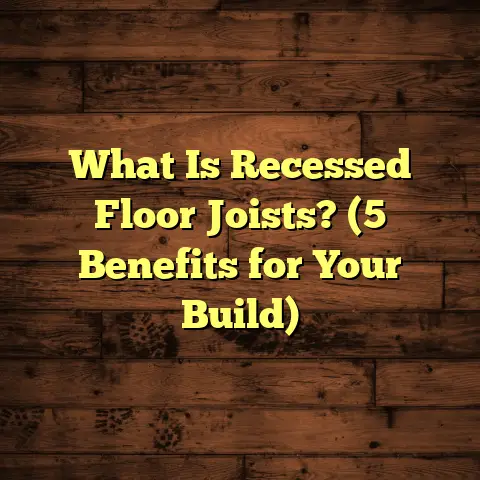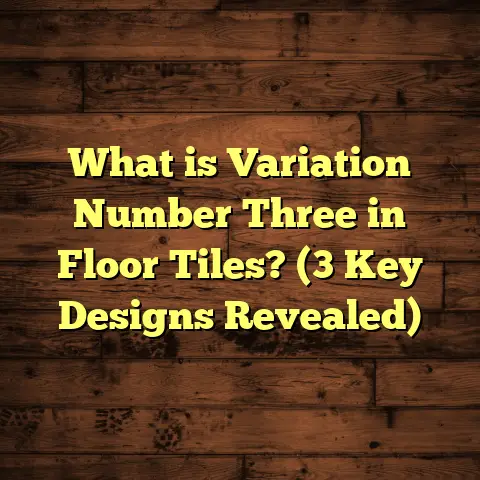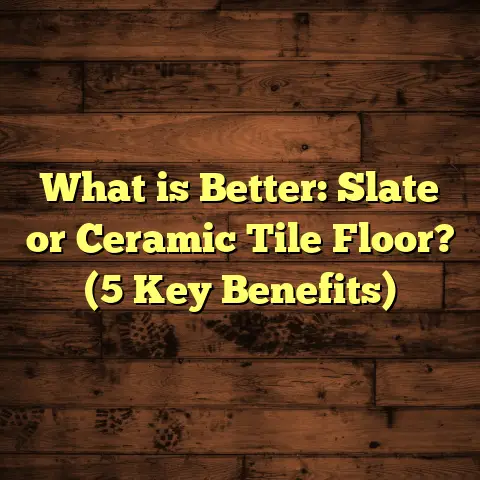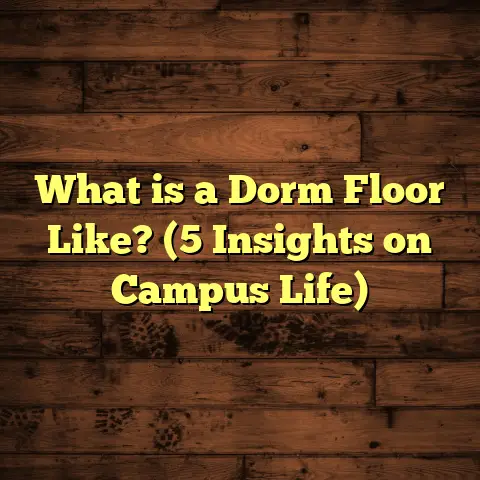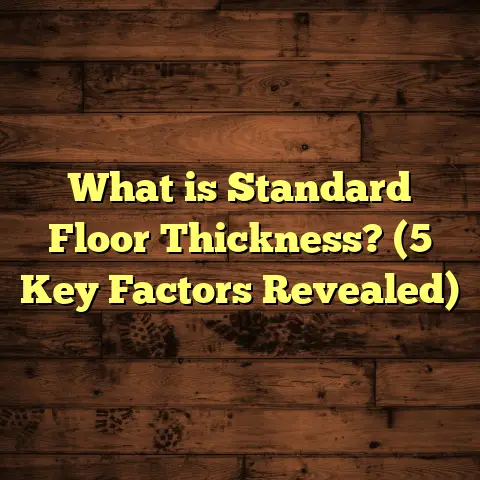What is an Unfinished Wooden Board Floor? (5 Benefits You Need!)
What is an Unfinished Wooden Board Floor?
You know, over the years, I’ve come across so many homeowners and DIY enthusiasts who are fascinated by the timeless beauty of wood floors but feel overwhelmed by all the flooring choices out there. One option that always stands out for me personally is the unfinished wooden board floor. If you’re reading this, you might be wondering exactly what it means and why it could be the perfect fit for your space.
So, let me start by breaking it down in a way that’s easy to grasp — an unfinished wooden board floor is simply a floor made up of raw wood planks installed without any finish on them. That means the wood hasn’t been stained, sealed, or coated in any way before installation. Instead, all the sanding, staining, and finishing happens after the boards are nailed or glued down.
This approach might seem like extra work or hassle compared to buying pre-finished wood planks that come ready to go. But trust me, this “extra step” opens up a world of possibilities for creating a floor that’s truly yours — customized in color, texture, and finish like nothing else.
Why I Believe Unfinished Wooden Floors Are a Game-Changer
When I first got into flooring contracting over a decade ago, I leaned heavily on pre-finished wood floors simply because they were faster to install. You just snap them into place or nail them down and—voila!—done.
But as I gained more experience, I noticed something important: unfinished floors offered something pre-finished floors just couldn’t match. The ability to customize every inch after installation, to work with the natural wood’s quirks and imperfections, and to apply finishes tailored exactly to the homeowner’s taste made unfinished floors a favorite of mine.
Let me share a quick story:
A while back, I was hired by a couple renovating their century-old farmhouse. They wanted their floors to reflect the home’s history but also feel fresh and modern. We chose unfinished hardwood boards — oak — and after installation, we sanded the entire floor smooth right there in the house. Then they picked out a stain that was a warm grayish-brown, something you rarely find pre-finished in stores.
The result? A floor that looked like it had been there for 100 years but had a clean, updated vibe. People who visited couldn’t stop complimenting it, thinking it was some rare vintage wood reclaimed from an old barn.
That experience showed me firsthand how unfinished wooden floors can transform a home’s atmosphere in ways factory-finished floors rarely do.
Benefit #1: Total Control Over Color and Finish
Let’s talk about one of the most exciting parts of unfinished wood floors — you get to choose exactly how they look.
With pre-finished floors, you’re picking from whatever colors and finishes the manufacturer offers. That usually means a limited palette: light oak, medium brown, dark walnut — maybe a few variations. But if you want something truly unique, your options are narrow.
Unfinished wood? That’s a blank canvas. You can stain your floor any shade you want or just leave it natural with a clear finish to let the grain shine through. Want something bold like ebony black or whitewashed? You can do that too.
I’ve helped clients pick out everything from classic honey tones to modern gray stains and even custom mixes of stains for multi-tonal effects. Once we finished on-site, those floors looked like custom works of art.
How to Nail Your Color Choice
- Test stain samples: Always grab leftover boards or buy sample planks to test stains in different lighting conditions in your home.
- Consider room size: Darker stains can make small rooms feel cozier but may also make them look smaller.
- Match your decor: Think about furniture and wall colors before deciding on your stain.
- Try layering: Sometimes applying a stain and then tinting it with a glaze adds depth.
Data point: A survey by the National Wood Flooring Association found that 65% of homeowners who chose unfinished wood cited “custom color options” as their top deciding factor.
Benefit #2: Superior Durability and Longer Lifespan
Here’s something I learned from years on job sites: unfinished floors generally last longer than pre-finished ones because of how the finish is applied.
Pre-finished floors are coated in factories using automated machines. While these finishes are high quality, there’s often uneven coverage on edges or joints after installation. Plus, minor scratches or gaps between boards can leave exposed wood vulnerable.
With unfinished floors, all sanding happens after installation — which means the wood surface is perfectly smooth and flush. Then the finish is applied directly on-site with care: every edge, seam, and nail hole gets coated thoroughly.
This method creates a more uniform protective layer that stands up better to wear and tear over time.
My Experience With Longevity
I managed a project about 15 years ago where we installed unfinished maple floors finished with a durable oil-based polyurethane. Last year, I revisited the home for maintenance, and aside from some minor scuffing near entryways, the floors looked as good as new.
In contrast, I’ve seen pre-finished floors needing refinishing within 8-10 years due to premature wear.
Pro Tip for Durability
- Use high-quality finishes like water-based polyurethanes or penetrating oils.
- Apply multiple finish coats (3-4 layers) for better protection.
- Maintain with gentle cleaning methods — avoid harsh chemicals or abrasive tools.
Benefit #3: Easier Repairs and Maintenance Over Time
Here’s something every homeowner worries about: what happens if your beautiful floor gets scratched or damaged?
With pre-finished floors, repairing scratches can be tricky because matching the factory finish isn’t easy. You might end up with noticeable patches where repairs were done.
Unfinished floors shine here too. Since the finish is applied on-site and you have control over it, small repairs just require localized sanding and re-finishing. No need to refinish the whole floor.
I’ve done this many times for clients with kids or pets who caused scratches or dents. A quick buff and touch-up made their floors look flawless again without breaking the bank.
Maintenance Tips I Always Share
- Use felt pads under furniture legs.
- Keep pet nails trimmed.
- Clean regularly with pH-neutral wood floor cleaners.
- Avoid wet mopping excessively; wood doesn’t like too much water.
Benefit #4: Cost Savings In Materials Over Time
At first glance, unfinished floors might seem more expensive because of the finishing labor after installation. But if you look closer at material costs alone — unfinished boards usually cost less per square foot compared to pre-finished options.
Why? Because you’re not paying for factory finishing upfront.
Plus, since you control what finish products you use (and how much), you can select options that fit your budget without sacrificing quality.
Rough Cost Breakdown (Based on Industry Data)
| Flooring Type | Material Cost (per sq ft) | Installation & Finishing Labor (per sq ft) | Total Estimated Cost (per sq ft) |
|---|---|---|---|
| Pre-Finished Hardwood | $5 – $8 | $3 – $5 | $8 – $13 |
| Unfinished Hardwood Boards | $3 – $6 | $6 – $8 (including finishing) | $9 – $14 |
Note: Costs vary by region and species of wood but generally unfinished boards give more control over materials cost.
My Advice on Budgeting
If budget is tight:
- Choose common species like oak or maple.
- Use water-based finishes that dry faster and cost less.
- Consider DIY finishing if you’re comfortable with some effort (I can guide you on this if you want).
Benefit #5: Authentic Natural Look That Ages Beautifully
There’s something truly special about wood that hasn’t been masked by factory coatings or synthetic finishes. Unfinished wooden board floors let the natural grain patterns, knots, and color variations shine through.
Instead of a uniform look, you get rich textures and character unique to each plank.
And here’s my favorite part: as these floors age and develop a patina from daily life, they gain warmth and personality that synthetic or pre-finished floors rarely achieve.
Many of my clients tell me their unfinished wood floors become conversation starters because of their natural charm.
What You Need to Know Before Starting Your Unfinished Wood Floor Project
If you’re leaning toward unfinished wooden board flooring, here are some insider tips from me that will save you headaches:
Choose Your Species Wisely
Different woods have different hardness levels, grain patterns, and staining behaviors:
| Wood Species | Hardness (Janka Scale) | Staining Behavior | Recommended For |
|---|---|---|---|
| Oak | 1290 | Takes stain evenly; versatile | Most homes; durable; classic look |
| Maple | 1450 | Can blotch if not pre-treated | Smooth grain; modern look |
| Hickory | 1820 | Varied color; rustic appearance | High durability needed |
| Pine | 420 | Soft; dents easily | Rustic charm; low traffic areas |
| Walnut | 1010 | Dark natural color; stains well | Luxurious look; moderate traffic |
Prep Your Subfloor Carefully
A solid subfloor is critical for unfinished boards because unevenness impacts sanding quality later on.
Make sure your subfloor is clean, level within 3/16 inch over 10 feet, and dry before installing boards.
Hire Professionals for Finishing
Sanding large areas evenly requires powerful machinery and skill to avoid damaging edges or creating dips.
Finishing products need proper application techniques and drying conditions for best results.
Common Questions About Unfinished Wooden Board Floors
Can I Finish My Floor Myself?
If you’re handy or like DIY projects, yes! Many homeowners successfully sand and finish their own floors using rental equipment from local hardware stores.
Keep in mind:
- It takes time (often several days).
- You need to follow safety precautions (dust masks, ventilation).
- Practice on scrap boards first to get familiar with staining.
How Long Does Finishing Take?
After installation:
- Sanding usually takes 1-2 days depending on area size.
- Staining takes a few hours plus drying time.
- Applying sealant coats takes several hours each with drying between coats.
Plan at least 3-5 days total before walking on the floor heavily.
What About Environmental Concerns?
There are many low-VOC (volatile organic compound) finishes available today that minimize harmful emissions during application and curing.
Water-based polyurethanes are popular because they dry fast and have less odor compared to oil-based options.
Real-Life Case Study: The Heritage Home Project
Let me tell you about one of my favorite projects — a heritage home renovation where we installed unfinished pine boards throughout the main living spaces.
The homeowners wanted a vintage feel but needed durable flooring because they had four kids running around daily.
We installed raw pine boards and finished them with a special combination:
- Light whitewash stain to keep things bright.
- Three coats of water-based polyurethane for durability.
- A final wax coat for extra protection and matte look.
The result? A floor that looked warm and inviting but stood up well to daily wear. After two years, the owners reported only minor touch-ups needed — nothing major like refinishing entire areas.
What I’ve Learned From Years Working With Unfinished Floors
- Patience pays off — rushing sanding or finishing leads to blotchy stains or uneven surfaces.
- Invest in quality products — cheap finishes wear out quickly.
- Test everything first — stains react differently depending on wood species and moisture content.
- Communication matters — working closely with homeowners helps tailor finishes to their lifestyle.
- Maintenance is key — even durable finishes benefit from regular cleaning and care.
Wrapping It Up: Is An Unfinished Wooden Board Floor Right For You?
If you want:
- Floors tailored exactly to your style,
- Greater durability,
- Easier long-term maintenance,
- Cost control over materials,
- Authentic natural beauty,
then unfinished wooden board flooring is definitely worth serious thought.
It may require more upfront effort but pays dividends in satisfaction every time you step onto your warm wooden floor.
If anything I shared sparked ideas or questions about your own flooring project, feel free to reach out! Whether you want help picking species or stain colors or need tips on finishing techniques, I’m happy to chat anytime.
Bonus: Quick Checklist Before Installing Your Unfinished Floor
- <input disabled=”” type=”checkbox”> Choose wood species based on hardness & look
- <input disabled=”” type=”checkbox”> Inspect & prep subfloor thoroughly
- <input disabled=”” type=”checkbox”> Plan finishing timeline (allow curing)
- <input disabled=”” type=”checkbox”> Select stains & finishes; test samples
- <input disabled=”” type=”checkbox”> Hire skilled installer/finisher or prepare tools for DIY
- <input disabled=”” type=”checkbox”> Protect floor after finishing (use mats & pads)
- <input disabled=”” type=”checkbox”> Develop maintenance routine (cleaning & touch-ups)
Thanks for sticking with me through this deep look at unfinished wooden board floors! There’s nothing quite like walking barefoot over smooth wood that you helped create. It’s a project worth every bit of effort for a home that feels truly special.
